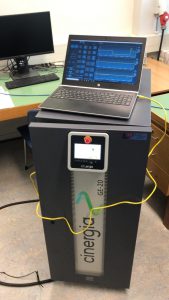Researchers study the influence of distortion on mains voltage
Mains voltage fault
Modern wind farms are connected to the mainland grid via long submarine cables with large parasitic capacitance. And they have a large number of power electronics converters that produce harmonics.
Harmonics are distortions of the sinusoidal grid voltage and current. The interactions between these harmonics and the wind farm components create a serious challenge. Higher harmonics are undesirable, because they can lead to energy loss, shutdown of protection systems and possible premature failure of components.
The current design approach is on a case-by-case basis with over-dimensioned components. This approach already leads to delays and price increases and poses risks for future expansions of the offshore grid for additional wind farms.
 Offshore wind research project
Offshore wind research project
A new research project has been launched at TU Delft to work together with companies and other research institutions on a more standardized, future-proof and cost-effective design approach. This design approach will increase the reliability and efficiency of offshore wind energy and thus make an important contribution to accelerating the energy transition and reducing integration costs.
Cinergia Grid Emulator from TTMS
At TU Delft, the section DC Systems, Energy Conversion & Storage (DCE&S) of the Electrical Sustainable Energy department conducted research using a 20kVA Grid Emulator GE+20 from Cinergia. The Grid Emulator supplied by TTMS is a programmable voltage source that can provide both a stable three-phase AC grid and a grid with electrical disturbances. Based on regenerative and bidirectional four-quadrant amplifiers, it is an important instrument for testing renewable energy sources such as solar energy, hydropower, combined heat and power and other grid-connected devices. In addition to the fundamental frequency, all harmonics up to the fifteenth can be programmed for each of the three phases separately. In addition, a freely selectable frequency is available between one tenth (0.1) and fifty times the fundamental frequency. In this way, a subharmonic, interharmonic or higher harmonic can be programmed. The Grid Emulator can also be used as a power amplifier for Hardware in the Loop testing and is equipped with a powerful and very user-friendly Windows interface.
The project at TU Delft provides increased knowledge about harmonic phenomena thanks to measurements with this Grid Emulator from Cinergia and results in a design methodology to limit the negative effects of harmonics.

Cooperation
The project is coordinated by TNO and supported by the RvO, under the TKI Wind op Zee program.
The DCE&S section is headed by Professor Pavol Bauer. The research is conducted by Lucia Beloqui Larumbe under the supervision of Dr. Zian Qin.
Source: TU Delft, Cinergia GE+ datasheet v2.